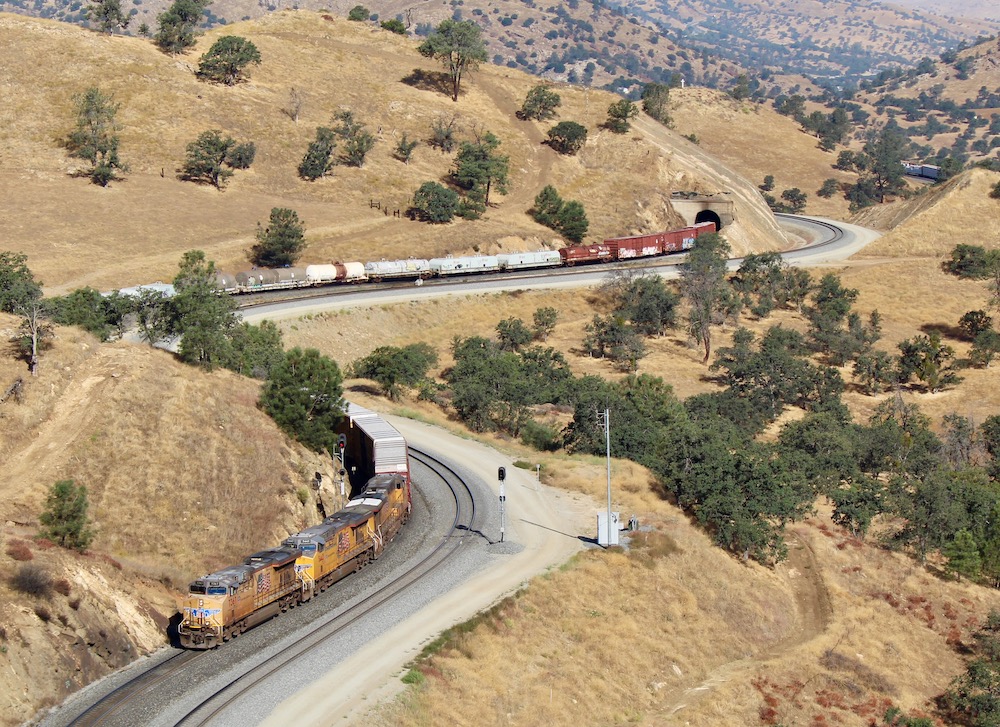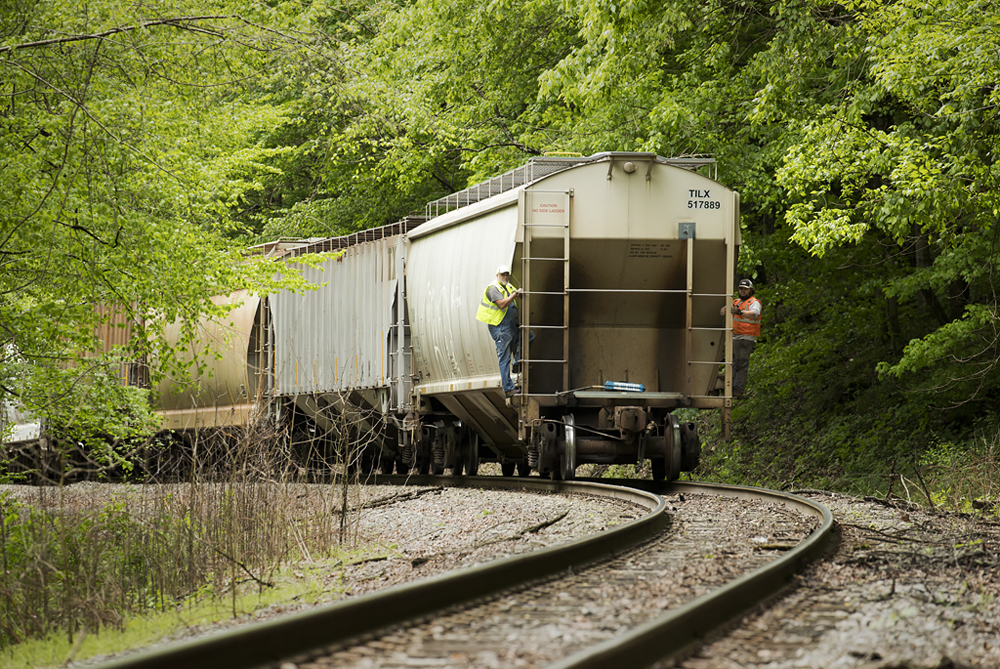
WASHINGTON — The Association of American Railroads says long freight trains are safe and has told the Federal Railroad Administration that there’s no need for an emergency order that would cap train length at 7,500 feet.
The Brotherhood of Locomotive Engineers and Trainmen on Oct. 9 called on the FRA to limit train length, claiming that trains longer than 7,500 feet pose an immediate safety hazard.

“Respectfully, there is no emergency,” Ian Jefferies, the AAR’s president, wrote in a letter to FRA Administrator Amit Bose on Oct. 12. “Railroads have safely operated millions of trains in excess of 7,500 feet over the last eight decades. Experience shows that these trains are safe. As such, there is absolutely no safety justification for the extraordinary step of an emergency order.”
The FRA issued a pair of non-binding safety advisories in April — one covering train makeup and one on the complexities of operating long trains — in the wake of several derailments that were related to a combination of train handling, train length and weight, and how tonnage was distributed throughout trains.
The FRA issues safety advisories to raise awareness and promote discussions around safety concerns, while an emergency order has the binding effect of a regulation and requires a higher burden of proof.
The April 27 train length advisory urged railroads to take steps to address the complexities of operating long trains. It was issued after three recent derailments involving trains with more than 200 cars, a length of 12,250 feet or more, and a weight over 17,000 tons.
“Since that time, nothing has happened to suddenly justify emergency action by FRA,” Jefferies wrote. “None of the derailments cited in BLET’s letter or FRA’s Safety Advisory were determined to have been caused by excessive train length. With the exception of the derailment in East Palestine [Ohio], which involved an overheated bearing, all involved train makeup or train handling issues.” (It should be noted that the National Transportation Safety Board has yet to issue reports on the cause of three of the four incidents cited in the BLET’s letter.)
The Class I railroads use a variety of methods to ensure safe operations, including train marshaling rules and the use of distributed power to manage in-train forces, AAR said. The railroads also require locomotive engineers to demonstrate in simulators that they can safely operate long, heavy trains before becoming qualified on a specific territory, AAR said.
The U.S. Class I railroads have increased train lengths since 2017 as part of a strategy to move tonnage on fewer but longer trains. Operating longer trains increases fuel efficiency and reduces the production of greenhouse gas emissions, AAR said, while also improving grade crossing safety by reducing the number of trains.
Mainline derailments have not increased since 2017, but the April FRA safety advisory said officials had “noticed a rising trend in recent incidents where train build and makeup have been identified as a potential cause or contributing factor.”
Recent studies that examined train length found no correlation with derailment rates, AAR noted, pointing to a 2019 Government Accountability Office report and a 2022 FRA report on Precision Scheduled Railroading.
“FRA’s Class I accident data for mainline accidents shows that over the last decade and across the system, accident rates have decreased as train length has increased,” Jefferies wrote.
The overall mainline accident statistics, however, do not show whether trains over 7,500 feet derail more or less often than trains under 7,500 feet.
Two years ago Congress funded a National Academies study on trains longer than 7,500 feet, which is currently under way. Congress also mandated that FRA collect accident and incident data on crew size and train length. Separately, FRA has begun a study of air brake performance in longer trains.
The FRA in July proposed requiring the Class I railroads to provide monthly data that tracks train length and tonnage as well as the number of reportable accidents for trains over and under 7,500 feet.
The FRA says it wants to use the data to better understand the impact of train length on safety and whether trains over a certain length are disproportionately involved in derailments or incidents such as stalls or a loss of communications.
In public comments submitted to the FRA, representatives from Amtrak, rail labor unions, the Illinois Commerce Commission, and the Chicago-area Coalition to Stop CPKC all backed the train-length data collection proposal.
The AAR opposed the rule proposal, arguing that the data collection would be burdensome, its low accident reporting threshold would make comparison with other years difficult, and that it undermines the FRA’s own proposal to mandate crew size.
An FRA spokesman said the agency is working on a response to the BLET’s train-length letter.














“The Association of American Railroads says long freight trains are safe” says the lobbying organization for the Class I’s and their Wall St. handlers, otherwise known as the AAR.
Sheesh.
Regarding the debacle of these mile plus long trains, how many people are going to die or be impacted by these long trains blocking grade crossings while first responders like the fire department or ambulances get stuck waiting for these trains to clear the crossing when minutes or seconds are and can be a matter of life and death and folks waiting on critical and life saving teams and are blocked from getting through. Technology is great but it can never replace the extra crew member or two that can catch things quicker than any robot or machine which of course has to be programed by humans anyway. Let us not put corporate greed and love of money and profits over human life. Besides these madman rail managers and the Wall Street syndicate that really runs these trains don’t have any idea of how a railroad works or operates and most likely never actually seen a train in operation or rode in one and when they need to get to their properties including the railroads they control ride in a private jet and then ride to their final destination in either a private car or limo. It is a sad state when there are really no more experienced railroaders running these railroads and with these mega mergers of these rail corporations only make things worse and more dangerous and results in unsafe and life threating situations for railroaders and the people living by the tracks and towns that these mile long monster trains roll through
Joseph C. Markfelder
Anyone know of an AAR member that’s actually worked on the rails? Armchair and model railroaders have must have never gotten off the locomotive in rain, excessive heat or freezing weather conditions and walked a train that suddenly goes into emergency. It can be a long walk to find the cause of the emergency braking. With trains being 2+ miles long, it will block crossings for quite some time. The concept of drive-by conductors waiting to repair hoses or knuckles is not a reasonable idea to me. We never know where the incident occurs or if it’s accessible by road. I don’t think they’ll drop a roving conductor down by helicopter. Drones can’t provide the exact location of the cause, yet. An idea not currently based in real life railroading.
Quote “Mainline derailments have not increased since 2017, but the April FRA safety advisory said officials had “noticed a rising trend in recent incidents where train build and makeup have been identified as a potential cause or contributing factor.” quote “The U.S. Class I railroads have increased train lengths since 2017 as part of a strategy to move tonnage on fewer but longer trains.”
So, number of derailments have not increased? But AAR says the number of trains decreased! If so, the rate has increased of accidents x number per million trains!
But longer trains are impacting the public in a negative way. Blocked crossings, longer times to receive emergency services, more persons climbing thru stopped trains, etc.
What would be interesting is if the Insurnace Institute did a study on how many persons died due to late emergency response. As well additional property damage due to late fire department response. Late police response to a situation?
just plain common sense says the longer the train the better chance for problems. I’ve been 30 years on the railroad and I see lots more problems with longer trains from more derailment to poorer customer service. the in train forces on these long trains are tremendous. and having distributed power only makes it worse because locomotives all act and load differently. but when you work for wall st it don’t matter.
That’s flat nonsense. The rate of derailments and accidents has *increased* as trains have become longer and more unwieldy. Longer trains exist solely and exclusively to reduce labor costs in an unsafe manner.
“The Brotherhood of Locomotive Engineers and Trainmen on Oct. 9 called on the FRA to limit train length, claiming that trains longer than 7,500 feet pose an immediate safety hazard.”
I’m willing to bet that this administration will side with the union. Just guessing.
Well that’s just how you know that they’re unsafe and totally unnecessary.
But then then the members of the AAR don’t care how many people they kill as long the stock price goes up a fraction of a cent.
in the name of realism and realistic operation, does that mean that we can run 100 car trains on our model railroad layouts or even a club layout that a large amount of space can now run 150-200 car freight trains on their layouts and not get any flak or complaints for doing so ?
Joseph C. Markfelder
Yes, perhaps more (and shorter) trains could increase the potential and frequency of accidents.
Another question is whether the Class I railroads could actually scrounge-up enough crews to run more shorter freights than fewer, longer ones. Yes, plenty of “parked” locomotives for the Class 1s to pull from storage lines, should they need them. However, operating crews (engineers/conductors) as well as more maintenance crews to maintain additional equipment in operation seems to me to be the big question, even assuming the Class I railroads could be encouraged (or coerced) to make this operational change.
It will likely take an act of congress to force this change on the Class Is ….
Time to stop this train length madness. It’s just pure greed on the part of the railroads. At very least no train should be longer than the available passing sidings.
More trains runs the risk of increasing the frequency of all types of accidents.